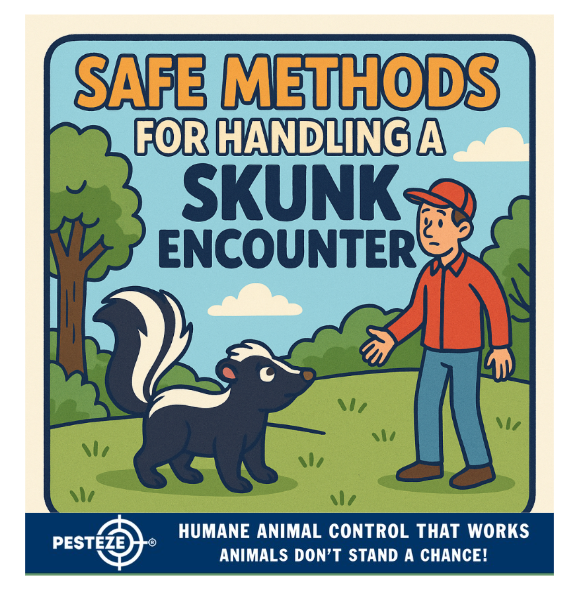SAFE METHODS FOR HANDLING A SKUNK ENCOUNTER

SAFE METHODS FOR HANDLING A SKUNK ENCOUNTER
SUMMARY
Skunks are shy animals that spray only when threatened, but an encounter can be stressful. Knowing how to handle these situations calmly and safely prevents sprays, injuries, and unnecessary harm. This guide explains safe methods for dealing with skunks and tips to avoid future encounters.
FEATURES
-
Stay calm and still: Sudden movements may startle the skunk.
-
Keep distance: Skunks can spray up to 10 feet—give them space.
-
Do not corner them: Ensure the skunk has a clear escape route.
-
Use gentle deterrents: Motion-activated lights or sprinklers work without harm.
-
Protect pets: Keep dogs and cats indoors until the skunk leaves.
-
Seek professional help: Call wildlife control if the skunk won’t leave on its own.
GUIDE DESCRIPTION
Skunks are common in suburban and rural areas, often foraging for food in trash bins, gardens, or pet bowls. While they are generally harmless, their ability to spray a foul-smelling liquid makes encounters unpleasant and sometimes alarming. Fortunately, skunks are not aggressive by nature and will usually retreat if given the opportunity.
The most important step during a skunk encounter is to stay calm and still. Skunks often spray only when they feel cornered or threatened. Sudden movements, shouting, or trying to chase them away increases the chance of being sprayed. Instead, quietly observe the skunk’s behavior. If it is sniffing or wandering, remain still and wait for it to move along.
Always maintain a safe distance. Skunks can spray accurately up to 10 feet. If you notice the skunk raising its tail, stomping its feet, or turning its back toward you, these are warning signs of a potential spray. Back away slowly without making eye contact or sudden gestures.
A critical mistake is to corner the skunk. Ensure the animal has a clear path of escape. Blocking its route may make it feel trapped, increasing the likelihood of spraying. Leave doors, gates, or yard exits open so the skunk can leave naturally.
If skunks become frequent visitors, consider using gentle deterrents. Motion-activated sprinklers, bright lights, or ultrasonic devices can discourage them without harm. Securing garbage bins, removing pet food at night, and sealing crawl space openings also reduce attractants.
It’s essential to protect pets during a skunk encounter. Dogs, in particular, may approach skunks out of curiosity, often resulting in a spray. Keep pets indoors until the skunk leaves and monitor outdoor areas before letting them back out.
For stubborn cases—such as a skunk that has taken shelter under a deck, shed, or porch—it’s best to contact wildlife control professionals. They have the training and equipment to safely and humanely remove skunks while adhering to local regulations.
By handling skunk encounters calmly, avoiding threats, and using humane deterrents, you can minimize risks and prevent future visits.
- Saneeth Thota


Comments 0